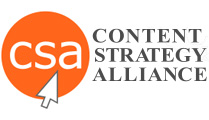By Kevin P. Nichols
(This is part of a series of articles highlighting the templates from Content Strategy Alliance Tools & Templates: A Best Practices Handbook.)
In the book, The Language of Content Strategy, Cleve Gibbon defines a content model as “a formal representation of structured content as a collection of content types and their interrelationships.” That is exactly what a content model is, a list of content types used within a content experience, such as a website, and the rules for those content types and the content within them.
In my book, Enterprise Content Strategy: A Project Guide, I note the importance of a content type, and I aver, “All content experiences start with a content type!” And a content model starts with a list of content types within an experience.
There are different levels of content model fidelity, some more conceptual and some more specific to every piece of content within an experience. This post features the detailed or what we call the ‘final content model.’ This content model starts as a more conceptual model and evolves into a comprehensive detailed blueprint for a content experience.
A content model is a powerful tool, and in addition to listing the content types within an experience, it helps with any type of component-based content management system, documenting the rules for each component within a content type, any intelligent content rules, personalization rules, and any other types of business logic in how content surfaces. It can also capture metrics and metadata, and information such as character lengths for fields such as a header or sub-header areas.
So a content model is a tool that captures a series of decisions made concerning content types, the modules or components that comprise each content type, and any special rules for each. Often, this document lives in a spreadsheet and is created by a content strategist with possible inputs from a business analyst and used by a technology team to implement within a platform, such as a content management system.
For Content Strategy Alliance Tools & Templates: A Best Practices Handbook, Jacqueline McAndrew and I worked together to create the structure for this content model; she then iterated upon it to create what you see today on the site. She then created the content model example, so that you can see how it appears populated. I believe this version of a content model is a strong example and is useful for many types of projects rolling out new content experiences.
I hope you find this tool useful and I welcome any feedback on how you have used it or how you think we could improve it!

